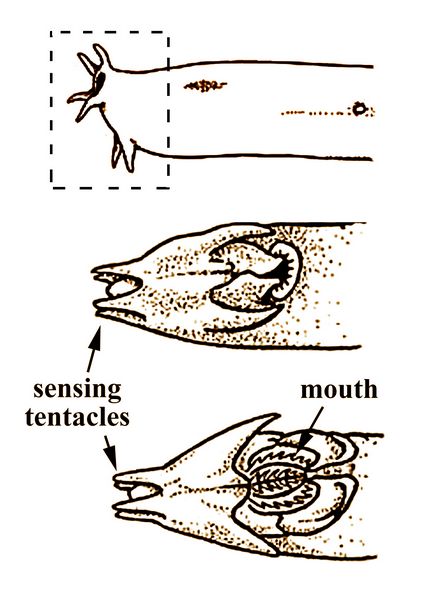Athena Review Image Archive ™
Myxini (hagfish)

Hagfish (Myxini) (after Nelson et al. 2016).
Hagfish are extant eel-shaped creatures, unique among living chordates in that they have a partial skull or cranium, but no vertebrae. The skeleton is composed of cartilage, and lacks bone. A total of 5 genera with 77 extant species of hagfish are known. Fossil hagfish from 300 mya show little difference in form. They belong to the phylum Chordata, the subphylum Cephalacordata, and the class Myxini.
Hagfish were once grouped with lampreys as Cyclostomata ("round mouth"), but are now considered a mixed group. They live on the continental shelfs of California. New Zealand, and East Asia, and feed on the bottom, mainly on dead fish and polychaetes (sea worms).
Hagfish have no larval stage. giving birth to miniature adult forms. This contrasts to lampreys, which have a long larval phase, and tunicates, whose notochord is confined to the larval stage. DNA evidence supports hagfish and lampreys as the oldest fish.
The body length of hagfish is from 4 cm to 1 m. They lack side fins, and have simple paddle-like tails. While their vision is poor, they have a vestigial third eye, sometimes marked on the top of the head. They have well developed senses of touch and smell, including four pairs of sensing tentacles arranged around their mouth, and two pairs of tooth-like rasps on top of a tongue-like projection. Similar sensing tentacles have been found on several Early Cambrian chordates. Hagfish have a partial skull or cranium, but their brains lack a cerebrum or cerebellum,
There are two fossil species quite similar to modern hagfish, both from the Pennsyvanian: Myxinikela siroka, and Myxineidus gononorum.
Reference:
Nelson, J. S.; Grande, T. C.; Wilson, M. V. H. 2016. Fishes of the World (5th ed.). John Wiley & Sons. :
Copyright © 1996-2020 Rust Family Foundation (All Rights Reserved).